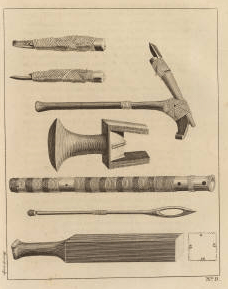Forster No. 65 is described in the Catalogue of Curiosities as 'A wooden dish or platter from which they eat'. It
was collected on Tonga by the Forsters either in October 1773, or in
June 1774, during the two visits to the islands made by the Resolution
and Adventure.
 |
| 1886.1.1553 Kava Bowl, Tonga |
The bowl is shallow enough to have been a food bowl, but it was more likely to have held kava. Kava was a drink made from the root of the kava plant, Piper methysticum. It was prepared and consumed in various ways throughout the Pacific. The root had to be broken down, either by chewing it, or by grating it on coral, and then it was mixed with water and strained. Kava is an intoxicating, non-alcoholic drink, which causes relaxation and later sleepiness. It
is believed to help break down social barriers, settle interpersonal
conflicts, and enhance social ties, and was an important part of Tongan
social life at the time of Cook's visits. Kava
was associated with rank, title and power on Tonga, and the communal
and ceremonial enjoyment of kava was very significant.
 |
| Kava Drinkers of the Friendly Isles, John Webber |
This sketch by John Webber, 'Kava Drinkers of the Friendly
Isles', as explained by Adrienne Keppler in 'James Cook and the
Exploration of the Pacific' (Thames and Hudson, 2009) shows 'the
interior of a large Tongan house with details of the bound rafter
patterns, the kava mixer mixer seated across from Paulaho (the highest
chief, or T'ui Tonga) with a large kava mixing bowl…and the men seated
in a circle of a ritual kava ceremony. During
Cook's time the (kava) root was chewed (by young people with good
teeth) and placed into the bowl before it was mixed with water and drunk
by the assembled group during state rituals or by chiefs at various
times of the day. The deities gave kava to to people and it was appropriate for people to offer it to the deities and their chiefly descendants.'
George Forster wrote of a kava ceremony on Tonga in October 1773 in 'A Voyage Round the World':
Forster had already noted that they had found a chief, 'a
middle-aged man, sitting on the ground at the trading place, and all the
croud forming a circle about him...The priest, who led our captains to
the places of worship, on the first day after our arrival, was seated
in the same circle,and drank vast quantities of the intoxicating
pepper-water, which was served in little square cups made of banana
leaves curiously folded. At his desire, we were politely presented with this dainty beverage, and in pure civility tasted of it. It had a nauseous insipid taste, which was afterwards followed by a strong pungency, and its colour was somewhat milky.'




